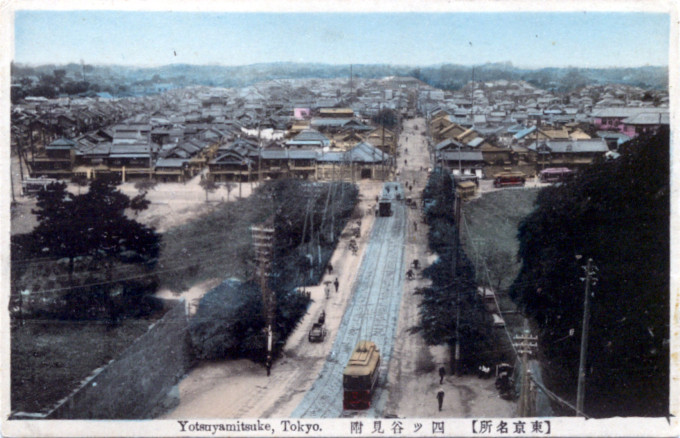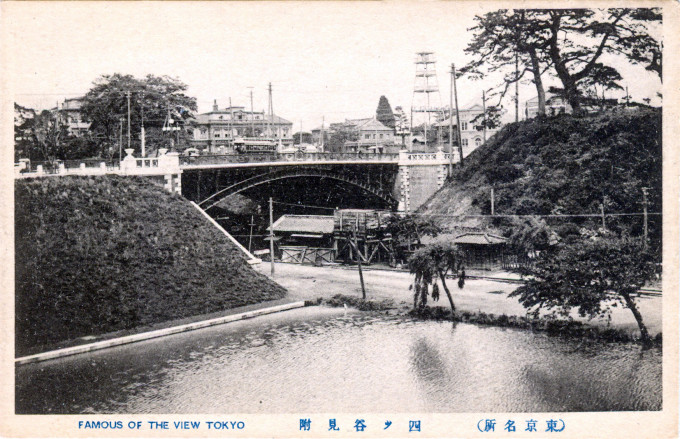
Looking across Yotsuya-mitsuke Bridge toward the northwest, c. 1915, with Yotsuya Station of the Chuo Line beneath.
See also:
Chuo Rapid Line (neé Kobu Line), Tokyo, c. 1910.
Kanda River.
Sophia University, Yotsuya, Tokyo, c. 1930.
“To ensure the unassailability of its stronghold, the bakufu [Tokugawa shogunate] skillfully utilized the Sumida and Kanda rivers to serve as large-scale moats. Tremendous construction projects were carried out … A particularly deep trench was dug at the Yotsuya Approach, the only point where the Kokyo Terrace was connected directly with the Musashi Plain.
“Inside the Yotsuya Approach, the one spot where the castle could be reached directly overland, three great allies of the bakufu – the daimyo houses of Kii, Owari, and Ii – were placed as guards. Accordingly, this location was later known by a combination of the first ideograph of the names of each of the houses: Kioi-cho.”
– Edo Culture: Daily Life and Diversions in Urban Japan, 1600-1868, by Matsunosuke Nishiyama (translated by Gerald Groemer), 1997

Yotsuya-mitsuke Bridge, completed in 1913, and Yotsuya Station (of the Chuo Line) beneath it, c. 1915. The tall structure right-of-center is the neighborhood fire-lookout tower (hinomi yagura).
“Before the growth of Edo, Yotsuya [four valleys] was a farming village outside the city. In 1634, with the digging of the outer moat around Edo Castle, many temples and shrines moved to Yotsuya. The moat had stone walls, and a mitsuke, an ‘approach to a castle gate’, was also built. Yotsuya mitsuke stood near the present-day Yotsuya Station. The relocation of the temples and construction of the mitsuke brought settlements of workers, and following the devastating Meireki fire [in 1657], many more people moved to Yotsuya, which had been spared. The gate was removed in 1872 and today only a small portion of the stone wall remains.
“Yotsuya developed rapidly due to its central location. In 1894, the Kōbu Railway, predecessor of the present-day Chūō Line, extended its existing railway line between Shinjuku and Tachikawa to Ushigome and opened Yotsuya and Shinanomachi stations. The railway enabled the easy transport of raw materials into the area; soon, pencil, tobacco and other industries moved in and began Yotsuya’s rapid industrial development.
“In 1911, the city of Tokyo began construction of a bridge at the outer moat to allow the highway to continue straight ahead. This is Yotsuya-mitsuke Bashi (Yotsuya-mitsuke Bridge) and it was completed in September 1913, with a French-style classic type design so as to be in harmony with the neighboring scenery.”
– Wikipedia

